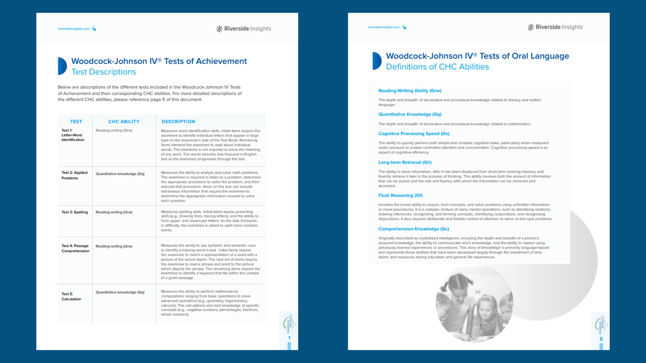What the Test? Explore the Advantages of Selective Testing
.png)
Don't ask this - What the test?
Instead ask - Which tests should I select to complete the most effective and efficient evaluation?
With increasing referrals, it’s more important than ever to be effective and efficient with testing. The good news? The organization of the Woodcock Johnson IV® (WJ IV™) reflects the principle that an examiner rarely needs to administer all the tests in a battery because different assessments require different test combinations. With it's extensive tool chest, the WJ IV was designed to support a selective testing model. That said, to streamline your assessment plans, it is crucial to understand what each test measures and how they might inform an evaluation.
Want a guide to understanding what each test measures? Download the 3 guides below.
What is selective testing?
Selective Testing is the careful selection of instruments to further assess skill areas pertinent to the referral concerns, when deemed necessary based on clinical judgment. It allows an examiner to obtain the most diagnostic information in the least amount of testing time, for any given individual’s unique needs, and may also be conducted based on an individual’s functional profile (e.g., pattern of strengths and weaknesses that emerges during testing) to provide further information that can be used for diagnostic purposes and educational program planning.
How can selective testing improve your practice?
-
- Selective Testing Improves Efficiency. Customizing your assessment plan helps you to work more effectively, moving quickly through your testing backlog and allowing you to use your time wisely, gathering the most relevant information about a student. A more targeted approach facilitates data analysis, which leads to richer and more robust intervention and/or program planning.
- Selective Testing Reduces Test Fatigue. More time testing results in test fatigue by both the examiner and examinee. This can result in unintended errors in administration and scoring, and frustration or a lack of engagement from the examinee. It also introduces increased variance; the more tests given, the higher the likelihood of greater variability within the data. This can lead to more uncertainty, making data analysis challenging, and clinically meaningful interpretations and recommendations more difficult to determine.
Ensure that you’re getting the most out of your testing time by reviewing and understanding each of the tests and what they measure. Download the guides below to get in-depth test descriptions and CHC ability definitions for all three of the batteries in the Woodcock-Johnson IV Test family.

If you become familiar with the test descriptions on these downloads, you can streamline your goals. You will have a solid understanding of what each test measures and how they might inform an evaluation, which will help you construct the most efficient testing plan.



.png?width=900&name=NEW%20Test%20Spotlight%20(2).png)
.png?width=900&name=NEW%20Addressing%20External%20Influences%20FEBE%20(2).png)
-1.png)